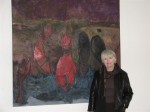A Grouch Worth Considering
Artist Kenn Kwint goes bonkers when he sees his first name spelled incorrectly. I’ve know him for 20-plus years, enough to know that he whines a lot, but who cares? This chap is a “painter’s painter.” In 1999, I attended his solo exhibit (Purely Painting) at the Haggerty Museum of Art and was thrilled to see him getting long-overdue recognition. Dr. Curtis Carter, the former Executive Director of the Haggerty, wrote the essay for the catalogue, and he got it right when he said, “Kwint concluded that the only way to learn to paint was through one’s own practice of the art.”
And practice he has, for more than 60 years. Over and over and over, and until recently, most of his paintings were produced in a studio in Walker’s Point, crammed to the rafters with huge paintings, smaller and mid-sized works on paper, notebooks filled with doodles and poetic thoughts, early ceramics and sculptures. I’ve been to his studio, and he seems to have explored just about every mode of making art. I’ve heard it said he’s “stuck in the abstractions of the ‘60s and ‘70s,” but his marks and symbols say a lot about who he is – complex, intelligent, driven. Exquisite and in-depth, his images are pulled out of layer upon layer of acrylic paint scratched through, dug out, and re-configured until Kwint (he’s his own harshest critic) is satisfied that the marks he makes hit the mark .
I never did dig his earlier “psychological masks;” they seemed less authentic than his pure abstraction, and in retrospect, perhaps the problem was that he was thinking too much, rather than laying on paint. Some of this psychological meandering was downright sloppy and lacked direction. They veered between the works of Francis Bacon, Leon Golub and DeKooning, but Kwint was savvy and devoted enough to stick with his lifelong journey of learning how to best express himself.
Over the years, I’ve heard Kwint fret about young artists who whip out immature paintings at warp speed, eager to get on to the next Big Thing. At age 70, Kwint has lived long enough to step back and consider what it means to devote his life to painting with passion. “I used to paint ‘round-the-clock,” he told me recently, but his health is not so good these days, so the time spent in his studio is limited. It bothers him, though he does have energy enough to retain his cynical take on the world. “Many of the young artists don’t even know how to spell ‘art’” he snipes. “Well, there are a few young locals who get what painting is all about,” he adds. He has little (or no) respect for artists rushing about in search of grant monies, artists who forget what it means to produce things worth considering, nor can he stomach gallerists who forget that they are not the ones producing the paintings. He avoids bullshit.
In the ‘60s and ‘70s, Kwint was in the publishing business (he ran Shore Press) and well-known around our town. His poems are archived in various university libraries, including the one at the University of Iowa. Early on, he noticed the considerable talents of contemporary writer Joyce Carol Oates and saw it fit to publish her poetry. I’ve been a fan of Ms. Oates (a UW-Madison grad) since the late ‘60s. The two share a similar, unblinking approach to making art.
If his health doesn’t worsen, his next project will be shaping and publishing a book of his major works. The world of publishing has changed dramatically since the Shore Press, but we both agree that these days, it will be easier and less expensive to produce a volume of his life’s work.
From now through January 5, 2008, at the Elaine Erickson Gallery (in the Marshall Building in the Third Ward) you can view a portion of what he’s accomplished. The exhibit’s title (Don’t Stop Looking At Art) is culled from a Kwint quote. I suspect that he intends for viewers to leave thinking that the best in this exhibit can’t be topped.
Elaine Erickson Gallery is located at 207 E. Buffalo St., Suite 120, in the Third Ward. Find more information at eericksongallery.com.






















